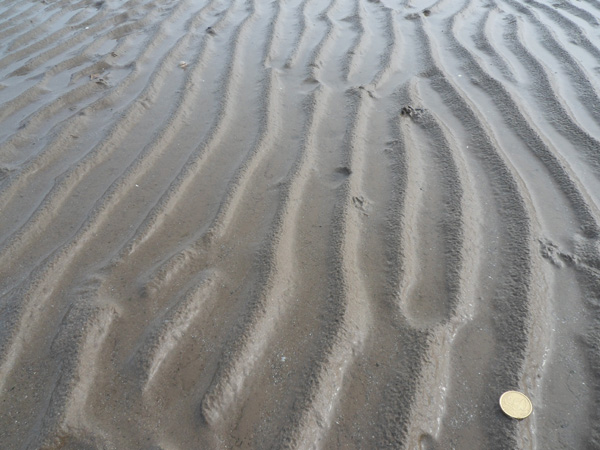Over 200 million years old
Impressions on Ancient Shore
A piece of sandstone from Scrabo, Co. Down, and the vanished world it represents.
By Alan O'Connor
Description
In the acquisition register of the National Museum of Ireland’s General Rock Collection, the entry for specimen NMING:R2972 (Fig. 1) reads:
“Sedimentary clastic, arenaceous (structural); sandstone. Ripple marks and desiccation cracks. Scrabo Hill, Co. Down. Triassic New Red Sandstone. Pres.: Dr J.S. Jackson, July 1968.”
The crests of the ripples in the specimen show bifurcation (splitting in two). This is a diagnostic feature of wave-formed ripples. Cracks on the ripple marks show that the sand underwent a period of drying out or ‘desiccation’ before it was buried and lithified (turned to stone). For comparison, a recent photograph of ripples from a modern beach is shown below, in Fig 2.

The Triassic World
The preserved ripples from Fig. 1 were formed between 250 and 200 million years ago, during the span of time known as the Triassic Period. During the Triassic, Ireland was located much further south, approximately midway between its current location and the equator. The prevailing climate would have been hot and arid. The environment was largely desert-like, though the preserved splashes of rain-drops are known from Scrabo.
At that time, the area now known as Ireland was not an island, but part of a large land area located at the eastern edge of the Pangaea supercontinent. It was not a lifeless place - plant spores as well as reptile and arthropod tracks have been discovered in Triassic rocks at Scrabo. The earliest dinosaur fossils are known from the Triassic - they were found in what is now South America. Modern mammals also appeared towards the end of the Triassic, although it would a further 150 million years or so before primates arrived on the scene. Remains attributable to modern man are thought to be approximately 100,000 years old.
How did this specimen come to be in the Museum?
The label on the specimen tells us that it was collected in July 1968 by the geologist Dr John Semple Jackson (1920-91). At the time he collected this specimen, Dr Jackson was Keeper of the Natural History Division.
Learn more
This particular specimen is part of the museum’s scientific collection, and is not on public display.
However, another specimen of sandstone showing ripple marks is on display. It was collected by Dr Jackson at the same locality, at the same time. It is specimen number NG:R2452, and it can be found in geology window case number 240 on the first floor of National Museum of Ireland - Natural History in Merrion Street.
References
- Briggs, D.E.G. and Crowther, P.R. (Eds) (2001) Palaeobiology II. Blackwell Publishing.
- Mitchell, W.I. (ed.) (2004). The Geology of Northern Ireland - Our Natural Foundation. Geological Survey of Northern Ireland, Belfast. Second Edition.
- Tucker, M. (1982). The Field Description of Sedimentary Rocks. Geological Society of London Handbook Series.
Acknowledgement
I am very grateful to Dr Matthew Parkes, Curator of Geology, for his assistance in preparing this article.
Location:
Impressions on Ancient Shore is located at:
In Storage
Previous artefact:
Here Be Dragons! A Wrought Iron Sienese Dragon
Next artefact:
